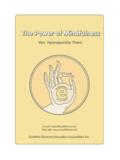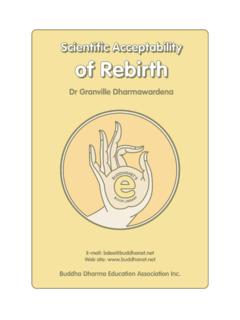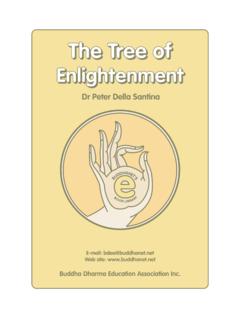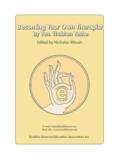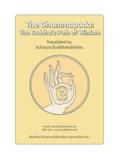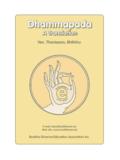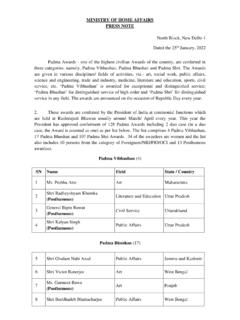Transcription of The Wisdom of Nagarjuna - buddhanet.net
1 EBUDDHANET'SBOOKLIBRARYE-mail: site: Dharma Education Association Peter Della Santina casuality and emptinessThe Wisdom of Nagarjunacasuality and emptinessThe Wisdom of Nagarjuna causality and emptiness The Wisdom of Nagarjuna Peter Della Santina Buddhist Research Society singapore causality and emptiness: The Wisdom of Nagarjuna Copyright 2002, Peter Della Santina Published by the Buddhist Research Society, No. 2 & 4, Lorong 24A Geylang Singapore 398526 Year 2002 ISBN 981-04-5657-3 (pbk) Printed in Singapore by Printing For free distribution causality and emptiness The Wisdom of Nagarjuna Peter Della Santina Buddhist Research Society singapore causality and emptiness: The Wisdom of Nagarjuna Copyright 2002, Peter Della Santina Published by the Buddhist Research Society, No.
2 2 & 4, Lorong 24A Geylang Singapore 398526 Year 2002 ISBN 981-04-5657-3 (pbk) Printed in Singapore by Printing For free distribution I dedicate this book to the late Khenpo Migmar Tsering, principal of the Sakya Institute of Higher Buddhist Studies, Rajpur, Dehra Dun, India. His Wisdom , compassion and genuine good humour are greatly missed by his students and friends. Table of Contents Author's Preface vii Part One: The Good Hearted Letter Section One: An Introduction to Nagarjuna 's The Good Hearted Letter 3 Section Two: The Good Hearted Letter with Explanatory Notes 8 Part Two: The Heart of Interdependent Origination Section One: An Introduction to Nagarjuna 's Heart of Interdependent Origination 49 Section Two: The Stanzas of The Heart of Interdependent Origination 60 Section Three: Nagarjuna 's Commentary to The Heart of Interdependent Origination 62 Part Three : Reasoning.
3 The Sixty Stanzas Section One: An Introduction to Nagarjuna 's Reasoning: The Sixty Stanzas 69 Section Two: Reasoning: The Sixty Stanzas 76 Section Three: An Explanation of Reasoning: The Sixty Stanzas Based on Candrak$rti's Commentary 84 Table of Contents Part Four : Emptiness: The Seventy Stanzas Section One: An Introduction to Nagarjuna 's Emptiness: The Seventy Stanzas 137 Section Two: Emptiness: The Seventy Stanzas 147 Section Three: Nagarjuna 's Commentary to Emptiness: The Seventy Stanzas 157 Notes 183 Table of Contents Author's Preface vii Part One: The Good Hearted Letter Section One: An Introduction to Nagarjuna 's The Good Hearted Letter 3 Section Two: The Good Hearted Letter with Explanatory Notes 8 Part Two: The Heart of Interdependent Origination Section One: An Introduction to Nagarjuna 's Heart of Interdependent Origination 49 Section Two: The Stanzas of The Heart of Interdependent Origination 60 Section Three.
4 Nagarjuna 's Commentary to The Heart of Interdependent Origination 62 Part Three : Reasoning: The Sixty Stanzas Section One: An Introduction to Nagarjuna 's Reasoning: The Sixty Stanzas 69 Section Two: Reasoning: The Sixty Stanzas 76 Section Three: An Explanation of Reasoning: The Sixty Stanzas Based on Candrak$rti's Commentary 84 Table of Contents Part Four : Emptiness: The Seventy Stanzas Section One: An Introduction to Nagarjuna 's Emptiness: The Seventy Stanzas 137 Section Two: Emptiness: The Seventy Stanzas 147 Section Three: Nagarjuna 's Commentary to Emptiness: The Seventy Stanzas 157 Notes 183 vii Author's Preface Genesis In the early seventies when I first went to India to study Buddhism, I soon came into contact with Sakya Trizin the forty first hierarch of the Sakya Order of Tibetan Buddhism and the Sakya community of scholars and monks which surrounded Him at Dehra Dun and Mussoorie.
5 It was who first introduced Jay Goldburg and myself to N@g@rjuna's The Good Hearted That happy event eventually led to a Translation of the letter which has been much appreciated over the years by students of Buddhism. Not long afterwards, I began to work on translations of some of N@g@rjuna's shorter texts which were then still untranslated. The first was very short indeed, N@g@rjuna's The Heart of Interdependent Despite of its brevity however, it proved to have more than enough in it to keep a young scholar occupied with it for sometime.
6 It still seems to me to be of indispensible for understanding the Buddhist conception of Interdependent Origination. The next work to attract my interest was N@g@rjuna's Emptiness: The Seventy It was of a totally different order from The Heart of Interdependent Origination. In the first place, it was considerably longer than the former. In addition, the subject matter was more difficult since it dealt with the key applications of the Philosophy of Emptiness. The translation of this text, accomplished with the help of Tibetan scholars of the Gelukpa and Sakya traditions, took place over a period of several years.
7 During the course of the translation of Emptiness: The Seventy Stanzas, I became increasingly interested in studying 1 Suh=llekha 2 Prat$tyasamutp@dah=dayak@rik@ 3/#nyat@saptati Causality and Emptiness: The Wisdom of Nagarjuna viii another of N@g@rjuna's shorter texts, Reasoning: the Sixty Finally, in 1985 when I was in Singapore working for the Ministry of Education, the opportunity to work on N@g@rjuna's Reasoning: The Sixty stanzas came my way. I was able to make a translation of the text with the Help of a Sakya scholar who was then resident at the Sakya center there.
8 Later I was also able to consult Candrak$rti's commentary to the work. In the course of time, I was able to construct an English rendering of the major themes of the commentary. The translation of the texts that appear in this book therefore were completed over a period of twenty years from 1971 to 1991. Two of the text included in this book have in fact appeared before in print. The first to do so was The Heart of Interdependent Origination. It was published in 1974 in the Journal of Buddhist Studies of the University of Delhi.
9 The next to appear was the translation of N@g@rjuna's The Good Hearted Letter in 1978. The remaining two translations have never been published. Of the two that have appeared earlier, the translation of The Heart of Interdependent Origination has remained largely unchanged although the introduction has been considerably expanded. In the case of N@g@rjuna's The Good Hearted Letter the translation has been revised at many places and the commentary completely rewritten.
10 N@g@rjuna declares that the Two Truths, the conventional and the ultimate, represent the profound Truth of Buddhism. The conventional truth is constituted by the practice of the path in conformity with the laws of cause and effect. The ultimate truth is none other than Emptiness. The four texts included in this book therefore represent the whole gamut of N@g@rjuna's Wisdom from the first practical steps to be taken on the path to Enlightenment to the final ending of all stress and bondage. N@g@rjuna's The Good Hearted letter has been used for centuries in India, Tibet and Mongolia as a basic manual of instruction for following the Buddhist way of life.
